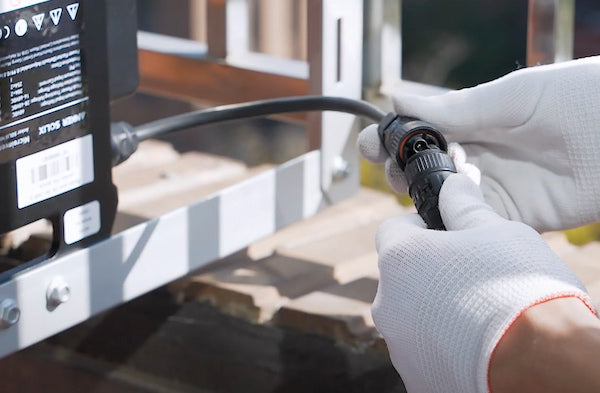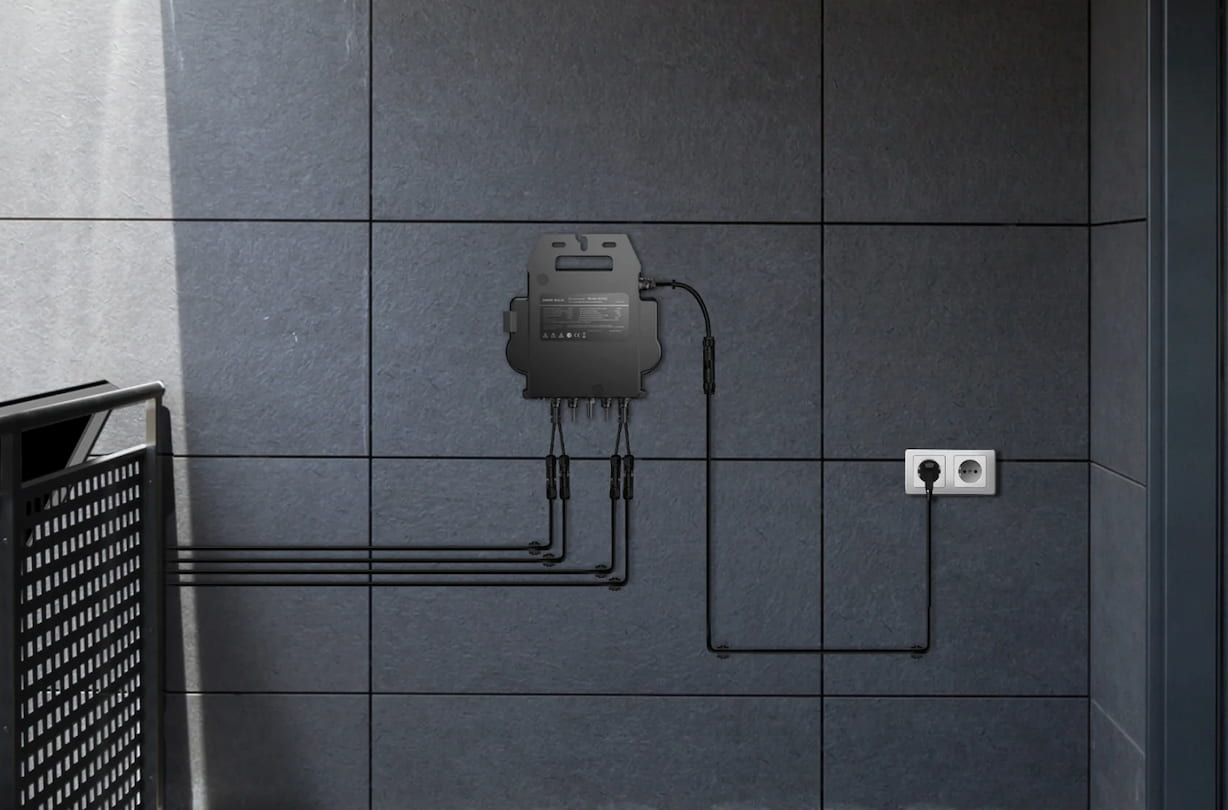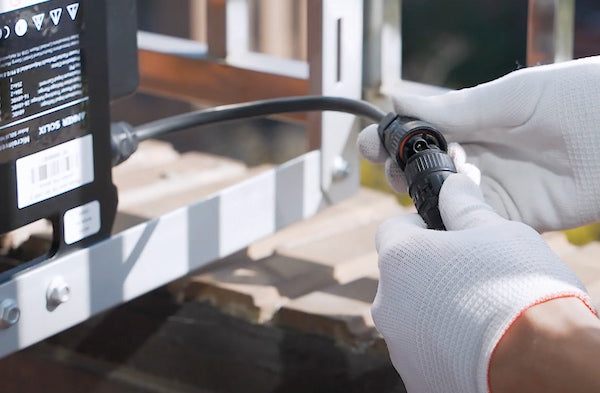
Connecting an Inverter to the House Network: A Comprehensive Guide
Share
If you’re riding the wave of sustainable living by harnessing solar power to lower your energy bills and reduce your carbon footprint, understanding the core components of your solar power system is crucial. Central to these systems is the inverter, a device that plays an essential role in transforming the energy generated by your solar panels into usable electricity for your home. Knowing how to connect the inverter to the house network is a key step in any solar setup.
This guide delves into the specifics of what an inverter does, explores various inverter types in solar systems, and walks you through a detailed, step-by-step process to connect your balcony power plant inverter to your home network correctly and safely.

What does an Inverter do?
An inverter is an essential component in any solar power system. Solar panels generate electricity in the form of direct current (DC). This is the initial type of electrical output produced when sunlight interacts with the photovoltaic cells in the panels. However, most homes and electrical appliances operate on alternating current (AC), not DC. This is where the inverter comes into play. Once the DC electricity is produced by the solar panels, it flows to the inverter, which then converts it into AC.
Inverters also play a significant role in the safety and efficiency of solar power systems. They ensure that the electricity output matches the voltage and current requirements of the grid and your home’s electrical circuits. Additionally, modern inverters come with smart technology that can provide data monitoring and energy management, which helps in maximizing the efficiency of your solar system by tracking production and usage patterns.
What are the Different Types of Inverters?
Inverters come in various types, each designed to suit different setups and performance needs in solar power systems. Here are the three primary types of inverters used in residential and commercial solar installations:
- String Inverters:These are the go-to choice for many residential solar systems. A string inverter connects a series of solar panels (a string) to convert their combined DC output into AC power. They work best where all panels receive similar sunlight without much shading. String inverters are relatively affordable and straightforward to install. However, if one panel in the string gets less light and performs poorly, it can drag down the output of the whole string.
- Microinverters:Unlike string inverters that handle multiple panels, microinverters are installed on each panel. This setup allows each panel to convert power independently, which can significantly boost your system’s efficiency—especially in complex roof layouts or areas where shading varies throughout the day. Microinverters help ensure that issues with one panel don’t affect the rest, and they make it easier to monitor and manage the performance of individual panels.
- Hybrid Inverters:These are like the multitaskers of the inverter world, combining the functions of standard grid-tie inverters and battery inverters. They not only convert DC to AC for your immediate needs but also channel any excess energy into batteries for later use. This feature is perfect for systems designed for maximum energy independence, allowing you to store power for when the grid goes down or during peak energy cost times. Hybrid inverters are becoming more popular in places with less reliable grid power or for anyone wanting to get the most out of their solar investment.
Can Balcony Power Plant Inverters Be Connected to a Home Network?
Yes, the inverter of a balcony power plant, also known as a “plug-and-play” solar system, can be legally and safely connected to your home network. These systems typically include one or two small solar panels and a micro inverter that can directly plug into a standard household electrical outlet.
In Germany, to qualify for this simplified plug-in connection method, the Renewable Energy Act (EEG) stipulates that the inverter used must comply with the VDE standards, and that the total output of the inverter must not exceed 600 watts, or 800 watts since 2024. This regulation ensures that the systems are safe and do not pose a risk to the public grid or the household electrical circuits.
A Step-by-Step Guide to Connect the Balcony Power Plant to the Home Network
With the right guidance, connecting a balcony power plant to your home network can be a straightforward process. Here’s a step-by-step breakdown of the process, using the Anker SOLIX Balcony Solar Power System (2*RS40B Panel 410W, Micro Inverter 600W/800W, Balcony Brackets) to illustrate:
{{component:"product", handle:"b5143", sku:"B514341D-EU"}}Install the Inverter
To successfully connect a balcony power plant inverter to your home network, start by choosing an optimal location for the inverter. It should be near both the solar panels and your intended socket to minimize cable length and reduce potential power loss. It’s also important to mount the inverter at a height that is easily accessible for regular maintenance and monitoring.
Ensure that the location is well-ventilated to avoid overheating, which can decrease the inverter’s efficiency and lifespan. Securely attach the inverter to the lower support beams of the mounting brackets or a wall in an area that is dry and shielded from direct sunlight or exposure to harsh weather.

Connect Solar Panels to the Inverter
Prepare to connect the solar panels to the inverter. Before starting, ensure that the inverter is turned off to avoid any electrical hazards. Route the cables from the solar panels to the inverter using the safest and most direct path.
Attach the output wires from the solar panels to the inverter’s designated input terminals, ensuring that each connection is tight and secure to prevent power loss and avoid electrical hazards. Use proper cable glands and conduits to protect the wires from physical damage and adverse weather conditions.
Connect the Inverter to the Home Network
In the case of the Anker SOLIX Balcony Solar Power System, connecting the inverter to your home network is a straightforward process that involves the use of a Schuko connection cable.
Begin by connecting the microinverter to the Schuko connection cable. Ensure that the cable’s plug aligns properly with the microinverter’s port. Insert the Schuko connection cable plug into your dedicated household socket. Make sure the connection is firm and that the plug is fully inserted into the socket to ensure a stable and safe electrical connection.

Conclusion
We hope this guide has illuminated the process and considerations involved in how to connect the inverter to the house network. By following the steps outlined in this guide, from installing the inverter to connecting solar panels and ultimately integrating the inverter into your home network, you can ensure a safe and smooth process. If you have any questions or need further assistance, don’t hesitate to reach out to a professional. Embrace the power of solar energy today and make a significant impact on both your energy bills and the environment.
FAQ
Can the inverter be connected to an outlet?
Yes, the microinverters designed for balcony power plants can be connected directly to a standard household outlet. These are often referred to as plug-and-play inverters. For this connection, a standard socket for protective contact plugs, commonly known as Schuko plugs, is adequate.
Where should the inverter be connected?
Ideally, the inverter should be mounted near the solar panels to minimize energy loss through long cables and in a place protected from direct sunlight and extreme weather, such as under an overhang. Additionally, it should be easily accessible for maintenance and close enough to your home’s power system for easy connection to the household electrical network.
Can I connect the inverter myself?
You can connect the inverter yourself if you are using a plug-and-play inverter used in balcony power plants. These inverters can be connected to a standard electrical outlet using a Schuko connection cable. However, if your system requires more complex wiring or you are not confident in your ability to safely handle electrical installations, it is recommended to hire a certified electrician. This ensures that the installation adheres to local electrical codes and safety standards.